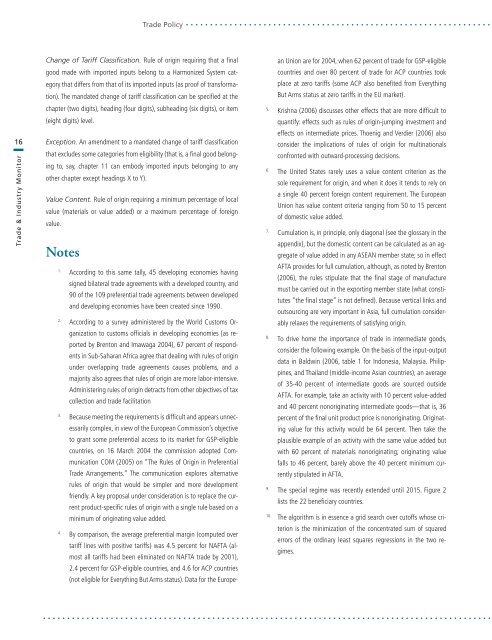Monitor Vol 39 08_Final_Nov08.pdf - tips
Monitor Vol 39 08_Final_Nov08.pdf - tips
Monitor Vol 39 08_Final_Nov08.pdf - tips
You also want an ePaper? Increase the reach of your titles
YUMPU automatically turns print PDFs into web optimized ePapers that Google loves.
Trade Policy<br />
16<br />
Trade & Industry <strong>Monitor</strong><br />
Change of Tariff Classification. Rule of origin requiring that a final<br />
good made with imported inputs belong to a Harmonized System category<br />
that differs from that of its imported inputs (as proof of transformation).<br />
The mandated change of tariff classification can be specified at the<br />
chapter (two digits), heading (four digits), subheading (six digits), or item<br />
(eight digits) level.<br />
Exception. An amendment to a mandated change of tariff classification<br />
that excludes some categories from eligibility (that is, a final good belonging<br />
to, say, chapter 11 can embody imported inputs belonging to any<br />
other chapter except headings X to Y).<br />
Value Content. Rule of origin requiring a minimum percentage of local<br />
value (materials or value added) or a maximum percentage of foreign<br />
value.<br />
Notes<br />
1.<br />
According to this same tally, 45 developing economies having<br />
signed bilateral trade agreements with a developed country, and<br />
90 of the 109 preferential trade agreements between developed<br />
and developing economies have been created since 1990.<br />
2.<br />
According to a survey administered by the World Customs Organization<br />
to customs officials in developing economies {as reported<br />
by Brenton and Imawaga 2004), 67 percent of respondents<br />
in Sub-Saharan Africa agree that dealing with rules of origin<br />
under overlapping trade agreements causes problems, and a<br />
majority also agrees that rules of origin are more labor-intensive.<br />
Administering rules of origin detracts from other objectives of tax<br />
collection and trade facilitation<br />
3.<br />
Because meeting the requirements is difficult and appears unnecessarily<br />
complex, in view of the European Commission’s objective<br />
to grant some preferential access to its market for GSP-eligible<br />
countries, on 16 March 2004 the commission adopted Communication<br />
COM (2005) on “The Rules of Origin in Preferential<br />
Trade Arrangements.” The communication explores alternative<br />
rules of origin that would be simpler and more development<br />
friendly. A key proposal under consideration is to replace the current<br />
product-specific rules of origin with a single rule based on a<br />
minimum of originating value added.<br />
4.<br />
By comparison, the average preferential margin (computed over<br />
tariff lines with positive tariffs) was 4.5 percent for NAFTA (almost<br />
all tariffs had been eliminated on NAFTA trade by 2001),<br />
2.4 percent for GSP-eligible countries, and 4.6 for ACP countries<br />
(not eligible for Everything But Arms status). Data for the European<br />
Union are for 2004, when 62 percent of trade for GSP-eligible<br />
countries and over 80 percent of trade for ACP countries took<br />
place at zero tariffs (some ACP also benefited from Everything<br />
But Arms status at zero tariffs in the EU market).<br />
5.<br />
Krishna (2006) discusses other effects that are more difficult to<br />
quantify: effects such as rules of origin-jumping investment and<br />
effects on intermediate prices. Thoenig and Verdier (2006) also<br />
consider the implications of rules of origin for multinationals<br />
confronted with outward-processing decisions.<br />
6.<br />
The United States rarely uses a value content criterion as the<br />
sole requirement for origin, and when it does it tends to rely on<br />
a single 40 percent foreign content requirement. The European<br />
Union has value content criteria ranging from 50 to 15 percent<br />
of domestic value added.<br />
7.<br />
Cumulation is, in principle, only diagonal (see the glossary in the<br />
appendix), but the domestic content can be calculated as an aggregate<br />
of value added in any ASEAN member state; so in effect<br />
AFTA provides for full cumulation, although, as noted by Brenton<br />
(2006), the rules stipulate that the final stage of manufacture<br />
must be carried out in the exporting member state (what constitutes<br />
“the final stage” is not defined). Because vertical links and<br />
outsourcing are very important in Asia, full cumulation considerably<br />
relaxes the requirements of satisfying origin.<br />
8.<br />
To drive home the importance of trade in intermediate goods,<br />
consider the following example. On the basis of the input-output<br />
data in Baldwin (2006, table 1 for Indonesia, Malaysia. Philippines,<br />
and Thailand (middle-income Asian countries), an average<br />
of 35-40 percent of intermediate goods are sourced outside<br />
AFTA. For example, take an activity with 10 percent value-added<br />
and 40 percent nonoriginating intermediate goods—that is, 36<br />
percent of the final unit product price is nonoriginating. Originating<br />
value for this activity would be 64 percent. Then take the<br />
plausible example of an activity with the same value added but<br />
with 60 percent of materials nonoriginating; originating value<br />
falls to 46 percent, barely above the 40 percent minimum currently<br />
stipulated in AFTA.<br />
9.<br />
The special regime was recently extended until 2015. Figure 2<br />
lists the 22 beneficiary countries.<br />
10.<br />
The algorithm is in essence a grid search over cutoffs whose criterion<br />
is the minimization of the concentrated sum of squared<br />
errors of the ordinary least squares regressions in the two regimes.
















